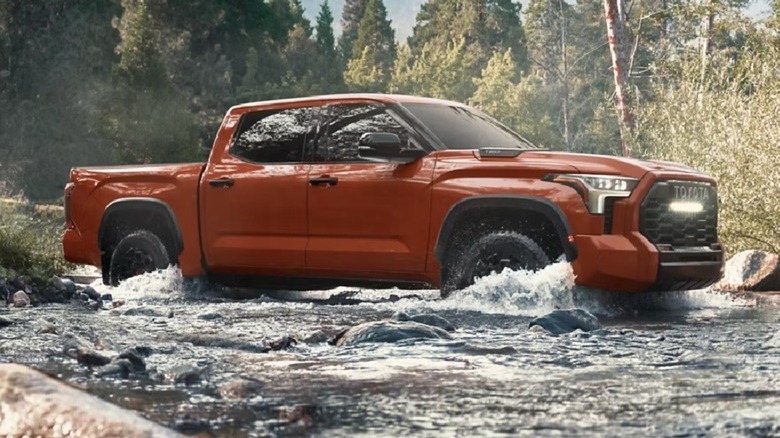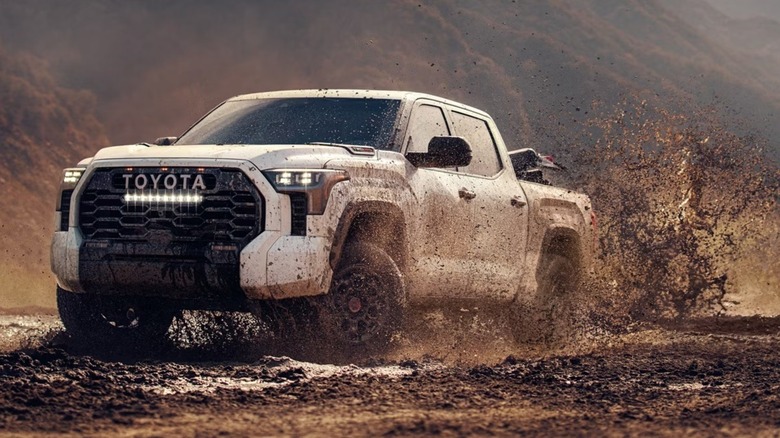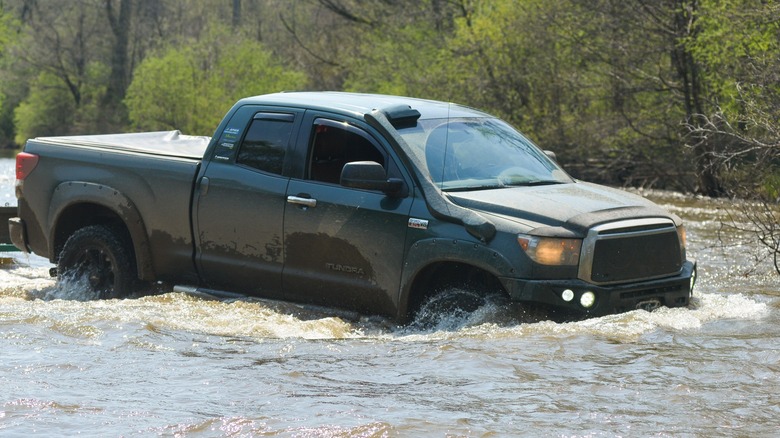How Much Water Depth Can A Toyota Tundra Handle Without Any Mods?
Part of the allure of owning a Toyota Tundra pickup truck, even the practical Tundra Platinum Hybrid, is its "work hard and play even harder" attitude, according to Toyota. During the course of its duties, the Tundra could see opportunities to drive through water deeper than a standard mud puddle, whether it's navigating flooded streets or fording mountain streams. And while there are other safety concerns to keep in mind when driving your truck off-road, water crossings are among the most serious.
We advise caution when driving through any body of water that doesn't allow you to see the driving surface below it due to its depth or lack of clarity. Flood waters, especially if fast-moving, can remove entire sections of roadways and bridges without warning. Even a slow-moving stream could contain a deep channel hidden in its depths.
However, as long as the surface under the water is suitable, the Toyota Tundra can handle water up to 28 inches deep. Of course, you'll need to take some precautions and continuously monitor the situation while driving slowly through deep water.
Toyota's recommendations for driving through deep water
According to the owner's manual for the 2023 Toyota Tundra, part of the current third-generation line of Toyota Tundra trucks, driving through water up to 28 inches deep is possible for trucks equipped with electronically modulated air suspension. This technology provides three settings for the Tundra's ride height: Low (LO), Normal (N), and High (HI).
The air suspension's HI-mode raises the truck frame and body 1.6 inches above the normal N-mode and is suitable "for driving on bumpy roads" under 18 mph. Driving faster than this causes the air suspension to return to normal height. LO-mode is designed to make passenger entry and exit, as well as loading and unloading cargo, easier by dropping the truck's height 1.2 inches below normal ride height. The LO ride height mode returns to normal at speeds over 8 mph.
Toyota recommends employing HI mode when crossing water deeper than 20 inches and locking out the self-leveling feature by switching the air suspension system into manual mode. While in manual mode at HI ride height, speeds should remain below 18 mph as the truck's higher center of gravity could make it easier to tip over.
The consequences of driving through water that's too deep
The 2023 Toyota Tundra owner's manual cautions that subjecting the Tundra to water depths that reach the doors, exceeding floor height, could result in serious damage to its electronics. The results could include power windows not working, the engine stalling, and the truck being unable to move under its own power.
In extreme cases of driving into deep water, you may find yourself in an emergency situation, stuck inside a vehicle that won't move. Toyota recommends exiting the truck with caution if it becomes stuck in the water. If the doors or windows cannot be opened due to the water's depth, the owner's manual says to remain calm and wait for rescue or open the door after the cab fills with enough water to equalize the pressure. Breaking a side or back window before the water rises is an option if the tools are available, but avoid trying to break the windshield as its laminated glass is harder to shatter.
Even if an emergency situation is avoided, driving into excessively deep water can have serious consequences for your truck beyond ruining its electronics. If water enters the truck's engine through the intake manifold while it's running, it could cause the engine to hydrolock. At the very least, this condition requires the removal of all the spark plugs to pump the unwanted water from the engine's cylinders. At worst, it could damage the engine's internal parts, including pistons, connecting rods, and crankshafts.


